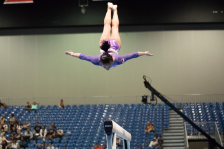Mat use in gymnastics trampoline and freestyle delivery
A generation ago schools were lucky if they had any more than one or two simple mats to use during indoor PE gymnastic activities. Much of the traditional gymnastic activity was done centre floor and it remains true that there is a great deal of basic gymnastic training that can done without the need for extensive and expensive mats.
Whilst the minimum ambition of 1 mat per 2 children may still seem to be out of reach for some schools this remains a reasonable expectation.
We have come a long way since the days of coconut fibre mats and long lumpy tumbling mattresses. The variety and cost of mats can now be confusing and alarming.
What is the mat for?
It has been demonstrated that even the most basic of mats can reduce the concussive effect of a head to floor impact enormously.
The main function of the simple school mat up to 2 centimetres thick is to provide a comfortable surface to lie or roll on and to provide the simplest protection for close floor activities to limit bruising and grazing. Most mats are now PVC covered making them more hygienic and less likely to cause friction burns. Interlocking flaps or Velcro connectors are a bonus to help avoid sliding. PVC, jigsaw flaps and Velcro are notoriously easily damaged.
The coconut mat gave way to compressed foam chip construction but now there are many types of advanced foams that are durable with excellent life expectancy and some that make lifting and storage easier.
Beyond the most basic of mats the consideration must be, “what is the activity?”
Modern mats come in almost any size or configuration and depth. What you deliver in the curriculum may still depend on your budget and what storage space you have.
10 CM landing mat
This normally has a sandwich of firm and soft energy absorbing foam. Its use can be for any landing at modest speed or from a modest height. The definition of modest has to be considered with the age, height and weight of the child. Can be used for simple vertical jumps or vaults from stable benches, small boxes or stools. The correct landing technique to gather up energy must always be taught first.
The old term “crash mat” is misleading in terms of intended use. This type of mat has high energy absorbing qualities. From height it can slow down the shock of a landing. Safety mats have many internal variants, but all have a relatively short lifespan depending less on age and more on use. They are expensive and so are often a rare one-off purchase.
Schools and clubs pride themselves in keeping their mats for many years. BEWARE, foams have an age lifespan and an even shorter usage lifespan. Misuse or mishandling can be a significant factor in lifespan. The safety mat’s purpose is to absorb energy and that energy is destructive to the foam. In general if the mat is losing its shape it is suffering.
No mat will fully compensate for poor technique or heavy uncontrolled landings. Mats are a “good teaching” resource and should never be considered to be a catch-all for having a pop at something exciting.
